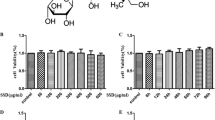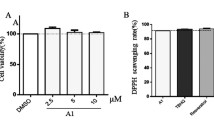Abstract
The purpose of the study was to investigate the protective effect and molecular mechanism of chondroitin sulfate (CS) against 6-hydroxydopamine (6-OHDA) induced toxicity in the human neuroblastoma cell line SH-SY5Y. The results showed that CS could protect SH-SY5Y cells against 6-OHDA-induced injury. The subsequent mechanism study showed that the anti-oxidation of CS may partly be mediated through inhibiting the intracellular reactive oxygen species overproduction, recovering the reduction of nuclear NF-E2-related factor-2 (Nrf2) expression and the reduction of antioxidants activity induced by 6-OHDA. Furthermore, CS pretreatment significantly attenuated 6-OHDA-induced cell apoptosis and nuclear condensation. 6-OHDA-induced dysfunctions, including the decrease of mitochondrial membrane potential (ΔΨm), increase of intracellular free Ca2+, imbalance of Bcl-2/Bax ratio, release of Cyt-c from the mitochondria and activation of caspase-3 and caspase-9 were attenuated by CS pretreatment, which demonstrated that CS suppressed 6-OHDA-induced apoptosis in SH-SY5Y cells possibly through mitochondria protection. These results suggest that CS exhibits anti-oxidation through the up-regulation of Nrf2 along with endogenous antioxidant, and reduces apoptosis via inhibiting the mitochondrial pathway to protect SH-SY5Y cells damaged by 6-OHDA.






Similar content being viewed by others
References
Anantharam V, Lehrmann E, Kanthasamy A, Yang Y, Banerjee P, Becker KG, Freed WJ, Kanthasamy AG (2007) Microarray analysis of oxidative stress regulated genes in mesencephalic dopaminergic neuronal cells: relevance to oxidative damage in Parkinson’s disease. Neurochem Int 50(6):834–847
Koprich JB, Reske-Nielsen C, Mithal P, Isacson O (2008) Neuroinflammation mediated by IL-1beta increases susceptibility of dopamine neurons to degeneration in an animal model of Parkinson’s disease. J Neuroinflammation 5:8
Jenner P, Olanow CW (2006) The pathogenesis of cell death in Parkinson’s disease. Neurology 66(10 Suppl 4):S24–S36
Egea J, García AG, Verges J, Montell E, López MG (2010) Antioxidant, antiinflammatory and neuroprotective actions of chondroitin sulfate and proteoglycans. Osteoarthr Cartil 18(Suppl 1):S24–S27
Volpi N (2011) Anti-inflammatory activity of chondroitin sulphate: new functions from an old natural macromolecule. Inflammopharmacology 19(6):299–306
Galtrey CM, Fawcett JW (2007) The role of chondroitin sulfate proteoglycans in regeneration and plasticity in the central nervous system. Brain Res Rev 54(1):1–18
Purushothaman A, Fukuda J, Mizumoto S, ten Dam GB, van Kuppevelt TH, Kitagawa H, Mikami T, Sugahara K (2007) Functions of chondroitin sulfate/dermatan sulfate chains in brain development. Critical roles of E and iE disaccharide units recognized by a single chain antibody GD3G7. J Biol Chem 282(27):19442–19452
Okamoto M, Mori S, Ichimura M, Endo H (1994) Chondroitin sulfate proteoglycans protect cultured rat’s cortical and hippocampal neurons from delayed cell death induced by excitatory amino acids. Neurosci Lett 172(1–2):51–54
Okamoto M, Mori S, Endo H (1994) A protective action of chondroitin sulfate proteoglycans against neuronal cell death induced by glutamate. Brain Res 637(1–2):57–67
Cañas N, Valero T, Villarroya M, Montell E, Vergés J, García AG, López MG (2007) Chondroitin sulfate protects SH-SY5Y cells from oxidative stress by inducing heme oxygenase-1 via phosphatidylinositol 3-kinase/Akt. J Pharmacol Exp Ther 323(3):946–953
Bové J, Perier C (2012) Neurotoxin-based models of Parkinson’s disease. Neuroscience 211:51–76
Niture SK, Kaspar JW, Shen J, Jaiswal AK (2010) Nrf2 signaling and cell survival. Toxicol Appl Pharmacol 244(1):37–42
Hwang YP, Jeong HG (2008) Mechanism of phytoestrogen puerarin-mediated cytoprotection following oxidative injury: estrogen receptor-dependent up-regulation of PI3 K/Akt and HO-1. Toxicol Appl Pharmacol 233(3):371–381
Finkel T (2005) Radical medicine: treating ageing to cure disease. Nat Rev Mol Cell Biol 6(12):971–976
Jordán J, Galindo MF, Tornero D, González-García C, Ceña V (2004) Bcl-xL blocks mitochondrial multiple conductance channel activation and inhibits 6-OHDA-induced death in SH-SY5Y cells. J Neurochem 89(1):124–133
Kruman II, Mattson MP (1999) Pivotal role of mitochondrial calcium uptake in neural cell apoptosis and necrosis. J Neurochem 72(2):529–540
Junn E, Mouradian MM (2001) Apoptotic signaling in dopamine-induced cell death: the role of oxidative stress, p38 mitogen-activated protein kinase, cytochrome c and caspases. J Neurochem 78(2):374–383
Hajnóczky G, Davies E, Madesh M (2003) Calcium signaling and apoptosis. Biochem Biophys Res Commun 304(3):445–454
Vander Heiden MG, Thompson CB (1999) Bcl-2 proteins: regulators of apoptosis or of mitochondrial homeostasis? Nat Cell Biol 1(8):E209–E216
Hartmann A, Hunot S, Michel PP, Muriel MP, Vyas S, Faucheux BA, Mouatt-Prigent A, Turmel H, Srinivasan A, Ruberg M, Evan GI, Agid Y, Hirsch EC (2000) Caspase-3: a vulnerability factor and final effector in apoptotic death of dopaminergic neurons in Parkinson’s disease. Proc Natl Acad Sci USA 97(6):2875–2880
Cho SG, Choi EJ (2002) Apoptotic signaling pathways: caspases and stress-activated protein kinases. J Biochem Mol Biol 35(1):24–27
Acknowledgments
The research is supported by National Natural Science Fund (No. 81441094), Natural Science Foundation of Shandong Province (No. ZR2013HQ010), Medical Scientific Foundation of Shandong Province (No. 2013WS0256), Qingdao Municipal Science and Technology Foundation (13-1-3-48-nsh), National Postdoctoral Research Project (2015M571999), Qingdao Postdoctoral Research Project and Young Foundation of Qingdao University.
Author information
Authors and Affiliations
Corresponding author
Rights and permissions
About this article
Cite this article
Ju, C., Hou, L., Sun, F. et al. Anti-oxidation and Antiapoptotic Effects of Chondroitin Sulfate on 6-Hydroxydopamine-Induced Injury Through the Up-Regulation of Nrf2 and Inhibition of Mitochondria-Mediated Pathway. Neurochem Res 40, 1509–1519 (2015). https://doi.org/10.1007/s11064-015-1628-8
Received:
Revised:
Accepted:
Published:
Issue Date:
DOI: https://doi.org/10.1007/s11064-015-1628-8




